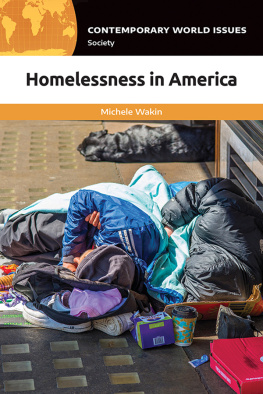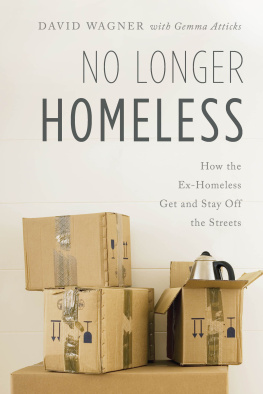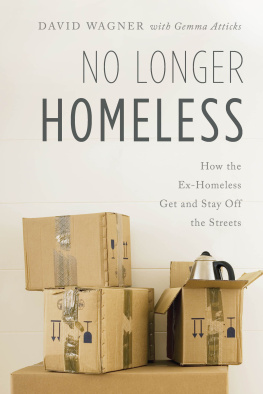Shadow Women
Homeless Womens
Survival Stories
Marjorie Bard, Ph.D.

Published by Sheed & Ward
An imprint of Rowman & Littlefield Publishers, Inc.
A wholly owned subsidiary of The Rowman & Littlefield Publishing Group, Inc.
4501 Forbes Boulevard, Suite 200
Lanham, MD 20706
Estover Road
Plymouth PL6 7PY
United Kingdom
Distributed by National Book Network
Copyright 1990 by Marjorie Bard, Ph.D.
All rights reserved. No part of this publication may be reproduced, stored in a retrieval system, or transmitted in any form or by any means, electronic, mechanical, photocopying, recording, or otherwise, without the prior permission of the publisher, except by a reviewer who may quote passages in a review.
Library of Congress Cataloging-in-Publication Data
Library of Congress Catalog Card Number: 90-60897
ISBN: 978-1-55612-358-0
Printed in the United States of America.
 The paper used in this publication meets the minimum requirements of American National Standard for Information SciencesPermanence of Paper for Printed Library Materials, ANSI/NISO Z39.48-1992.
The paper used in this publication meets the minimum requirements of American National Standard for Information SciencesPermanence of Paper for Printed Library Materials, ANSI/NISO Z39.48-1992.
Contents
Introduction
They spend nights hidden in cars, cemetery crypts, and buildings under constructionor openly in such twenty-four hour havens as Atlantic City hotel-casinos, transportation terminals, and coffee shops. They spend days in malls, libraries, and hospital complexes. They eat their way through grocery stores, use coupons for free or inexpensive food, and dine-and-skip in busy restaurants. They are clean, dressed and coiffed neatly, and seem serene. They look and act like normal shoppers, gamblers, dawdlers, and visitors, but they are solo homeless womenmainly over forty years of age and surprisingly well educatedwho blend into polite society. These shadow women may roam from place to place or establish a relatively permanent daily routine within any radius that suits waking and sleeping needs. I found (and still find) them in all urban and suburban areas: uptown, downtown, crosstown, beach; touristtown, tracktown, port town, and retreats.
I know them and their ways because I was one of them. I escaped a nomad life when I was accepted at UCLA for graduate study, and financed by grants obtained an M.A. and a Ph.D. (My doctoral dissertation focuses on the topics of domestic abuse and homelessness correlated to organizational and community involvement.) During my academic days I also worked at a shelter for battered women, acted as a victim advocate in the Los Angeles City Attorneys Office, and founded an organization to provide direct services to pre-homeless and homeless women. Currently I assist other organizational representatives in efforts to design, fund, and implement programs and projects for abused and homeless women. Consequently, this book is a fifteen-year field journal of womens personal experience narratives concerning why and how they became and remain homeless. The stories reflect community and system responses and needs.
While public and private sector personnel and researchers pursue quantitative and qualitative information-gathering regarding the urban homeless in America (with conflicting data and inferences), there is a dearth of knowledge related to the lone homeless woman who is neither unmistakeably and/or dysfunctionally mentally ill nor highly visible as a streetscene, mission, or shelter member. There is also little information regarding those urban homeless who dwell on the fringes of citiesnot strictly within the boundaries of what we label city or town, but not properly classified as rural. They straddle what academics and professionals carefully try to divide: urban, suburban-urban, suburban, and rural. A large number of homeless individuals travel from one community to another, staying for varying amounts of time in what may be within a citys limits only to move on to find refuge in suburbia-bordering-on-countryand then return to what cannot be denied as an urban area.
The qualitative material presented in this book about a population of homeless women who have been heretofore unperceived and therefore unexposed points to a significant rise in any quantitative data about homeless people. There are obviously large numbers of people who escape the censustaker, professional, and academic. In addition, this material provides new inferences concerning who is and may become homeless; there are millions of housewives, widows, and employed women who do not even suspect that they are at risk.
The women whose stories appear here continuously engage in ingenious methods for finding safe shelter, seeking daily sustenance, and practicing some form of financial gain. They define innovation, and we respect a self-reliant, survivalist attitude. Each woman indicates that she communicates problems and visions to herself and selected others to maintain personal dignity and identity and an acceptable public image. We all understand that need; we do the same. But psychologically, spiritually, socially, and economically these women are on the brink; some will continue to balance precariously between self-sufficiency and the dreaded mission or street syndrome, some will slip into a downward spiral never to regain current standards, and others appear to be creeping back up the ladder to a possible reintegration into mainstream life. Strategy seems to be the root metaphor for survival. Disguise (or perhaps camouflage), composure, and guarded conversation combine as a public mask. Sturdy-and-stylized department store bags, large purses, and clothing with voluminous pockets substitute for the dead giveaway: the shopping basket filled with belongings (although recently I note the use of very fashionable fabric-covered carts). Many homeless women have keys to private lockers, and some have post office boxes, bank accounts, and safety deposit boxes.
Almost all of such homeless women have been responsible for ownership or rental of houses or apartments in the past (as opposed to having been dependent on a parent). The majority are not only high school graduates but have some college background (and an astounding number have bachelors degrees, masters degrees, and Ph.D.s); and while over 75% have been housewives, only a few have not had any experience in some formal workingplace environment. Most of the women refer to becoming overnight indigents, but a large number drift into a static or nomadic lifestyle after sporadic attempts to live with relatives or friends. Some are victims of the act(s) of one or more persons, while others have experienced dual victimization: by individual(s) and the system. It is interesting to note that while almost all are articulate about economic, political, social, and religious systems, the information which they have about Social Security, Disability, and other government benefits is too often incorrect. Whether they were provided with that misinformation (and thus became victims of the system) or deduced it themselves is usually unknown; the important fact is that many could be receiving a monthly stipend which could alter their circumstances. With all of their background differences, they end up with one thing in common: they have become borderline members of society who are always in our midst but remain either unrevealed or incognito to all but the occasional confidant or other homeless women who see a reflection of themselves.
I am of two minds about this book. I am divulging the secrets of survival for innumerable women who dwell in semi-privacy and desired anonymity. I fear that I am betraying not the confidences regarding the situations and behaviors which have brought them to their current status, but the manner in which they are staying alive and relatively sane. We do not expect people to be
Next page







 The paper used in this publication meets the minimum requirements of American National Standard for Information SciencesPermanence of Paper for Printed Library Materials, ANSI/NISO Z39.48-1992.
The paper used in this publication meets the minimum requirements of American National Standard for Information SciencesPermanence of Paper for Printed Library Materials, ANSI/NISO Z39.48-1992.